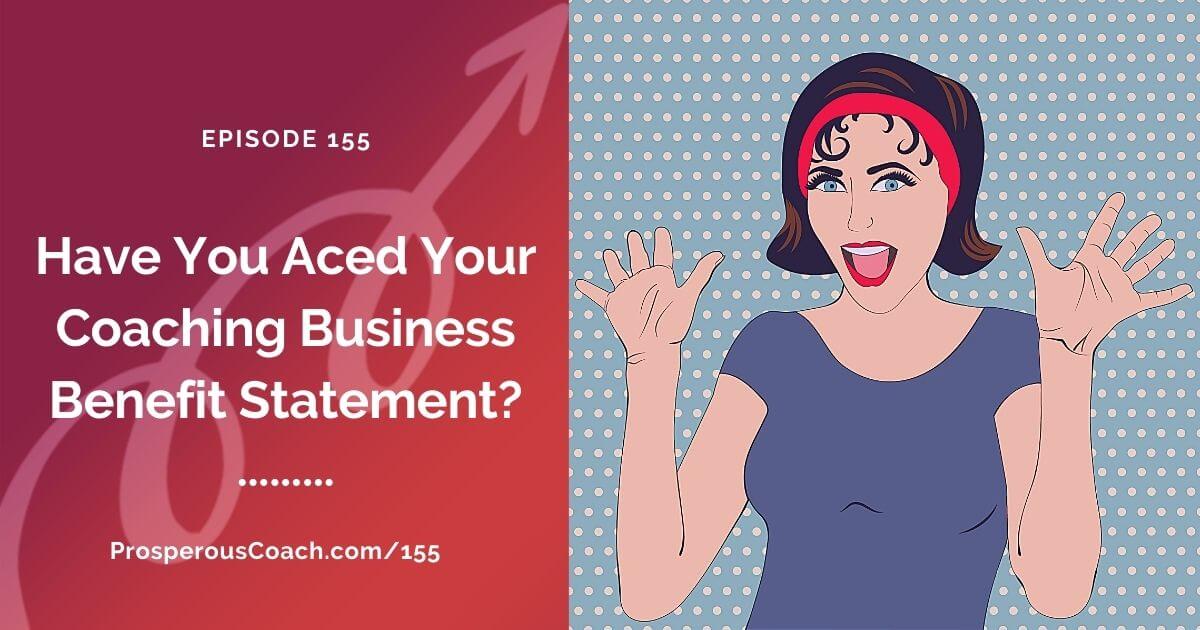This episode is for all the coaches out there struggling to tell people what they do in a way that gets a positive response.
Many coaches design a statement to tell people what they do. It’s a misunderstanding that your benefit statement is about you or coaching. Those tend to be non-benefit statements.
For example:
I coach people to live the life of their dreams.
How would most people respond to this message? Their eyes would glaze over and they’d disconnect. People do want to live the life of their dreams. But it doesn’t feel believable. It feels like a pie in the sky. Unbelievable messages don’t inspire a strong positive response — such as to hire you!
To make messages believable so they inspire a strong positive response, you need SPECIFICITY.
Your Core Message for Your Coaching Business
Your benefit statement is the first and arguably most important message for your business. That’s why I call it a CORE Message. Some people call it a HUB Statement. The point is that message is at the center of all of your messaging. And every other message you create springs from the central ideas in your Core Message.
The statement”I coach people to live the life of their dreams” won’t grab attention for two main reasons:
- It’s missing a critical part of the coach’s niche — the target audience.
- And it’s also missing specific outcomes the target audience knows they want. “Live the life of their dreams” is a vague and abstract concept.
Why do I say “the target audience KNOWS they want”? Because if they don’t know they want it, they won’t be out there seeking solutions.
A beautifully crafted and highly effective benefit statement names your target audience in specific terms then goes on to name specific outcomes the audience knows they want. Not all the outcomes but the top of mind desired outcomes.
Let’s break down the NON-benefit statement into components.
1. First, there’s the lead in phrase: “I coach”. I recommend “I help …” instead. For one thing it doesn’t immediately raise concerns about what coaching is. But also a coach is not something most people know they want.
If you haven’t already, please listen to Episode 7 and then Episode 153, which both explain why coaching is a hard sell so you don’t want to push that language – coach, coaching etc.
Why use “help”? Well, for one thing it’s a single syllable word and easy to connect with the rest of a benefit statement. When I wrote curriculum for Coach Training Alliance I suggested “I work with” but I’ve long since realized that makes sentences awkward.
Also a coach IS a helper – a thinking partner. You’re not going to solve problems for your clients. You’re going to help them solve problems and reach goals.
2. Now let’s look at the word “people”. This is a NON niche — no target audience. Someone said: If you try to serve everyone, you’ll serve no one. I agree. Even “people who …”, like “people who want more from life” is arguably not going to be a narrow enough target audience to have a sustainable business.
3. How about the phrase “to live the life of their dreams”? This is the big zero. There’s nothing to hook onto here that inspires the response “I want this!” because it’s trying to cover all the bases.
Coaching Benefit Statements That Sing!
So let’s say this coach focuses on careers, how could the message change for the better? First, they need to target a specific audience. For example:
Stay at home moms re-entering the workforce
Do you see how the specific audience description is tempered by a situation that effectively names an outcome the person wants? That’s the basis of both the niche and possibly the benefit statement.
But I’d make the statement more evocative by adding more specificity.
I help moms bridge their career gaps
to land flexible, meaningful work.
Beautiful! Every word is highly relevant and evocative to the unique audience.
Now, this benefit statement belongs to a real coach, Lee Koles – a past client of mine with a smart business called Career Sequel. She has a fantastic blog and LinkedIn presence too. Check it out if you or someone you know has been a stay at home mom and is ready to get back into the job market.
Do NOT usurp this benefit statement or any that I share. I share real examples with you so you can learn how specificity takes a ho hum statement and makes it an attention grabber.
Here’s another excellent benefit statement:
I help parents empower their teenage daughters
to build confidence, integrity and resilience for all of life’s adventures.
If you have a teenage daughter you know this is something you want for them. Pass forward Shawna Warner of Cultivating Resilient Teens to anyone your know with a teen daughter!
You’re going for impact with your benefit statement. Less is more is a great principle for all writing. And I’ve heard some people say stick with 15 words or less. It’s a guideline but not a hard fast rule. You definitely don’t want a run on benefit statement. Here’s my own, which comes in at 16 words:
I help coaches earn more and market less
by choosing a highly profitable niche they’ll love.
So, now, how can you make your benefit statement more specific and therefore more evocative and effective?
It starts by knowing your target audience and what they want so much they’ll invest in your help to get it. Then wordsmith so your message is a powerful statement that’s highly relevant. You can do it!

